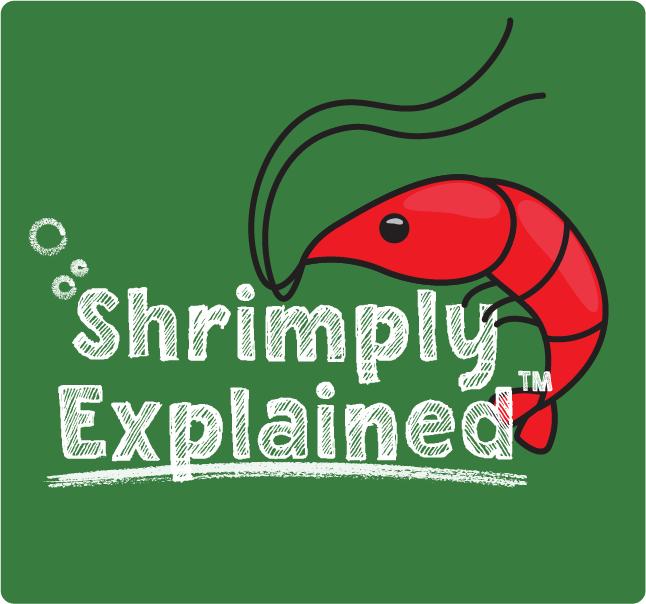

Dwarf shrimp like neocaridina (i.e. red cherry, blue dream, green jade shrimp) and caridina (i.e. crystal red, blue bolt, black king kong shrimp) have a very interesting reproduction cycle. Like humans, they reproduce sexually so both a male and female are needed to make baby shrimp. Females also have similar anatomical parts like ovaries where eggs develop. Understanding the process of how dwarf shrimp eggs develop is really useful because it helps shrimp keepers identify what behaviors and appearances are normal - and those that aren't. The rest of this article takes a look at the four steps in dwarf shrimp egg development so you know exactly what to expect when your shrimp breed! We also developed a tool that estimates the day eggs will hatch so you can be on the lookout for baby shrimp at the right time, which you can access here.
If you'd like an overview of the entire lifecycle of dwarf shrimp, then check out this video on our YouTube channel:
Other Shrimp Content
We have a lot of content coming soon. Please follow us on social media and subscribe to our newsletter for updates and useful shrimp care tips!
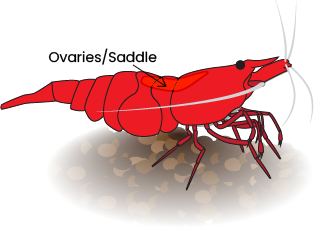
Oogenesis is the point where new eggs develop in your shrimp’s ovaries (sometimes referred to as their “saddle”). This development is closely coupled with a shrimp’s molting cycle so both molting and reproductive hormones must be carefully controlled within a female shrimp’s body so eggs are ready to be fertilized when the shrimp is ready to molt.
New shrimp keepers often worry when they see the saddle develop, as it often looks like a weird dark growth through opaque shells. As long as the growth is only between the abdomen and head, as shown in the model, there's nothing to worry about. If you see the growth spread throughout their body, then it may be a bacterial infection called "Milky Shrimp Disease" or muscular necrosis.
Shrimp typically become sexually mature at 50-90 days of age, depending on temperature, at which point they will fertilize eggs after their next molt. Temperature affects the speed of all shrimp development, with faster temperatures leading to faster development/growth rates. Higher temperature may seem best but it can stress them out and increase bacterial/fungal growth so higher temperature is not always better.
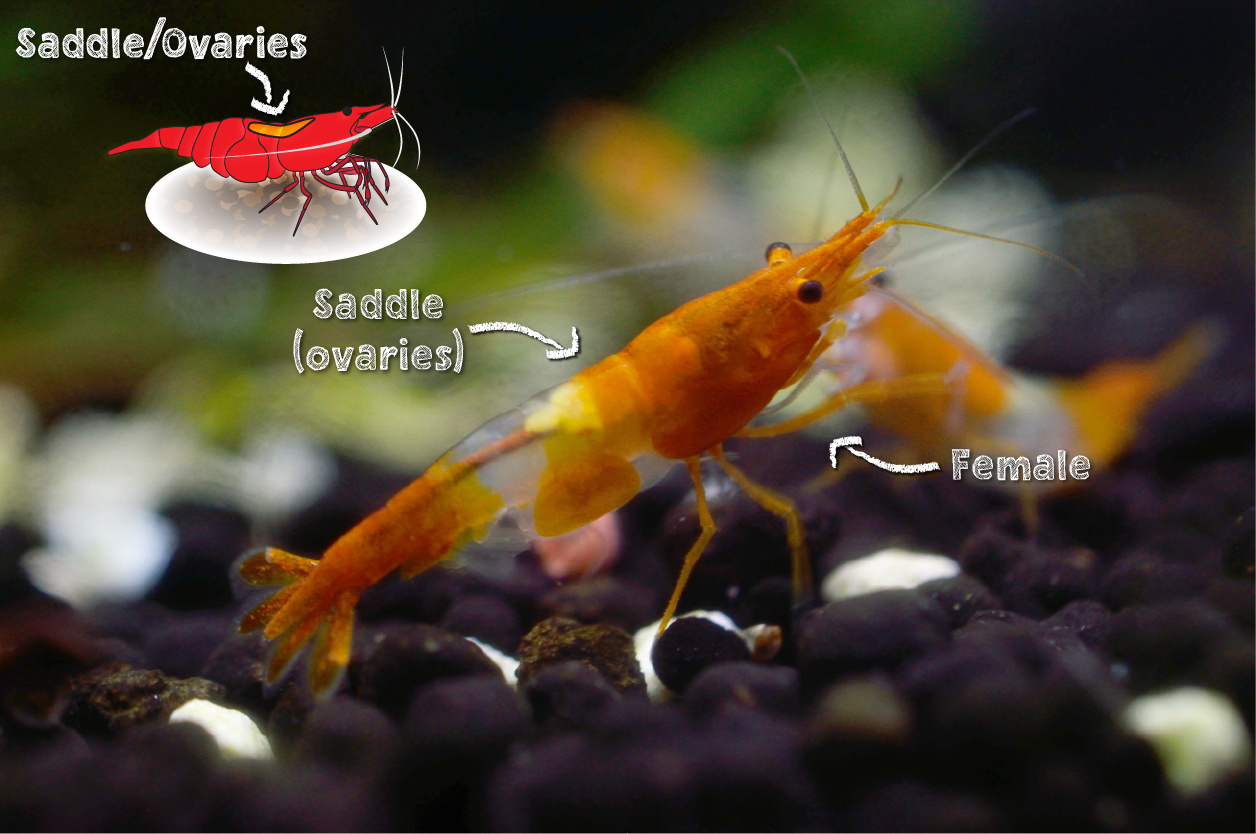
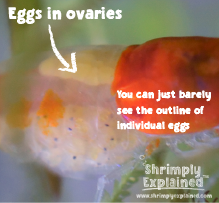
Upon close inspection through transparent shells, you can often see individual eggs developing in the ovaries!
Shrimp reproduce sexually so sperm from a male shrimp is required to fertilize eggs carried by a female. This process starts with females releasing pheromones (chemicals that attract males) into the water before she molts, allowing males to find her. After molting, she mates with a male to receive a sperm packet in her thelycum between the back pairs of periopods (walking legs). Mating can happen anywhere from 5 seconds to 5-10 minutes after molting. Here's some shrimp porn:
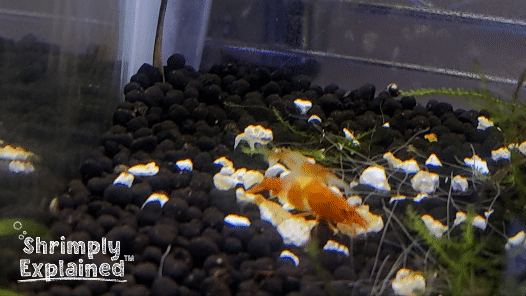
After receiving the sperm packet, the female finds a safe place to hide. Once safe, she moves the eggs out of her ovaries, through the thelycum and sperm packet, and onto her pleopods (swimmerets). A sticky substance holds the eggs together and keeps them attached to her swimmerets for the rest of their development. This process typically happens within an hour or two of mating.
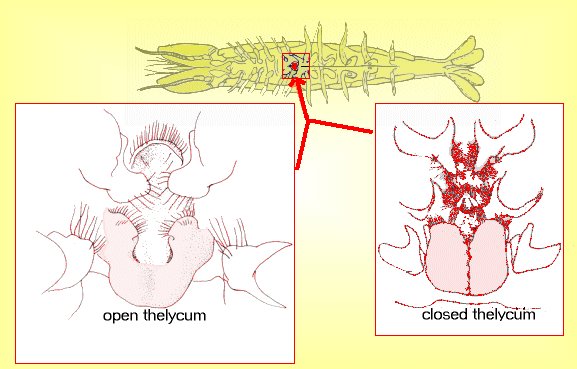
The thelycum is located under female shrimp between their rear pairs of walking legs.
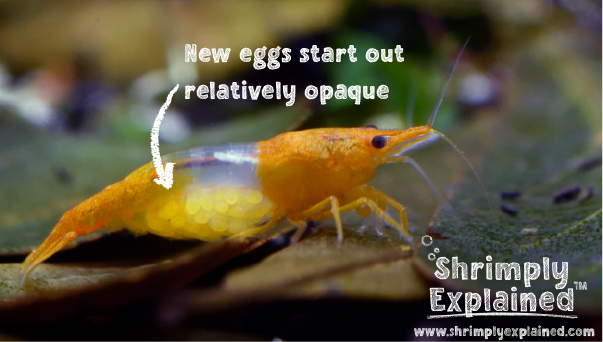
Once eggs reach the swimmerets, they take anywhere from 15-30 days to develop in normal aquarium temperature ranges. Eggs typically start out as relatively opaque yellow spheres, but they can also be green, white, or even blue! It is not clear exactly what causes eggs to be different colors but most eggs in the clutch tend to be the same color, at least if they are all viable.
As the embryos mature, eggs become more translucent. You can often tell when eggs are within a few days of hatching because two tiny black spots will appear on the eggs. These are the developing eyes!
During egg development, the mother moves her swimmerets up and down at varying rates. This moves fresh water around the eggs so they stay oxygenated and (hopefully) free of infection. The most common problem during this phase is a white, fuzzy fungus that grows between the eggs, which happens when water quality is less than ideal. For more information on water quality and how to improve it in shrimp tanks, please take a look at this article!
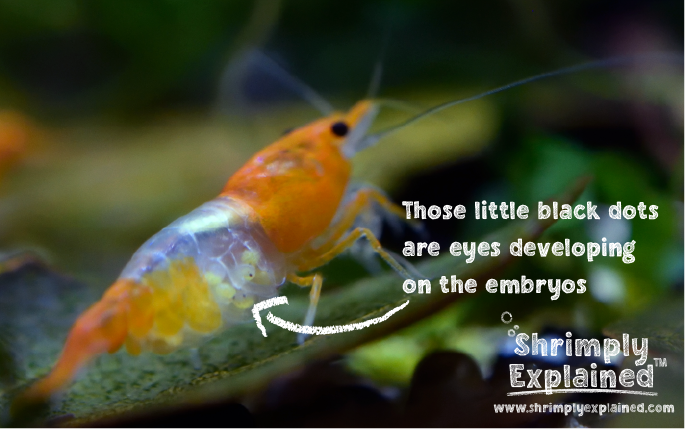
After fully developing, the juvenile shrimp break free of their egg to live life on its own! At hatching, baby shrimp—shrimplets—are about 3mm long and mostly transparent. They still carry a small amount of their yolk with them to prevent starvation over the first 5-8 days while they find shelter and sufficient food. After that, juvenile shrimp need a steady supply of food for the rest of their lives to continue growing. This typically comes in the form of detritus (dead plant/animal matter) and biofilm (bacterial growth). To encourage biofilm growth, we recommend using a bacterial powder like BacterAE in your tank. Click here to learn what BacterAE is made of and how the ingredients help your tank.
At this young age, shrimp grow rapidly, molting an average of 7 times within the first 20 days! As they get older, molting frequency decreases, eventually trailing off to once every 1-2 months once they hit adult size, at which point they reach sexual maturity and continue the lifecycle.
Want to find out when your shrimp's eggs will hatch? Click here to check out our Egg Hatching Date tool to receive the estimated date you'll see baby shrimp!
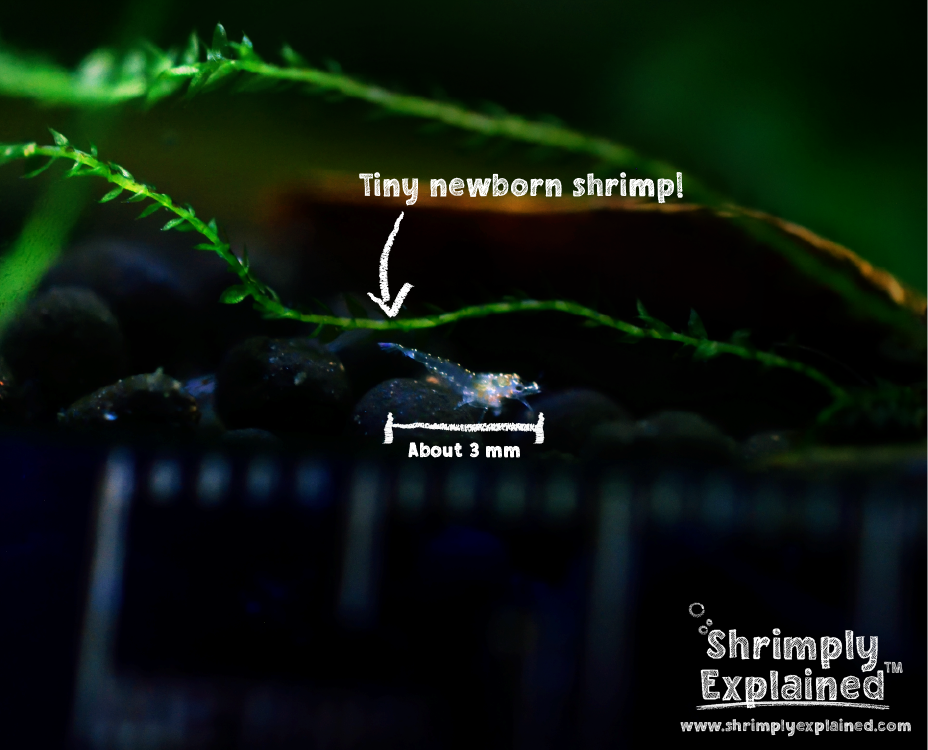
A newborn shrimp is about 3mm and mostly clear. This one just has a few spots of pigments!
Now you have a much better grasp on the fascinating process of how dwarf shrimp eggs develop. Remember that those early days are critical though. Good water quality and a sprinkling of BacterAE give shrimplets the best chance for a healthy start. Soon, these tiny creatures will be joining the adults, foraging, molting, and maybe even starting a new generation of their own.
When you see this amazing development for yourself, hopefully it sparks your curiosity and encourages you to ask more questions about shrimp and their environment. Shrimply Explained is here to answer questions and provide answers to important shrimp keeping questions you may not even be aware of yet! Up your shrimp game by subscribing to our email (The Chitin Chronicles) below. You can also visit The Shrimp School or our blog for more information.
F.A.H. Nur and A. Christianus, 2013. Breeding and Life Cycle of Neocaridina denticulata sinensis (Kemp, 1918). Asian Journal of Animal and Veterinary Advances, 8: 108-115.
João Alberto Farinelli Pantaleão, Samara de P. Barros-Alves, Carolina Tropea, Douglas F. R. Alves, Maria Lucia Negreiros-Fransozo, Laura S. López-Greco, Nutritional Vulnerability in Early Stages of the Freshwater Ornamental “Red Cherry Shrimp” Neocaridina Davidi () (Caridea: Atyidae), Journal of Crustacean Biology, Volume 35, Issue 5, 1 September 2015, Pages 676–681, https://doi.org/10.1163/1937240X-00002357
Tropea C, Stumpf L, López Greco LS (2015) Effect of Temperature on Biochemical Composition, Growth and Reproduction of the Ornamental Red Cherry Shrimp Neocaridina heteropoda heteropoda (Decapoda, Caridea). PLoS ONE 10(3): e0119468. https://doi.org/10.1371/journal.pone.0119468